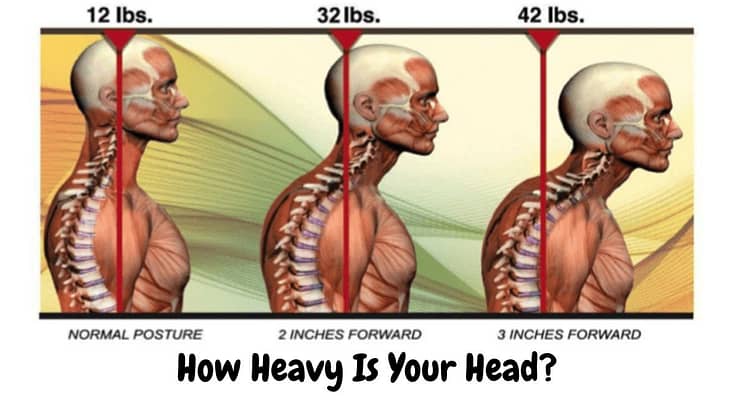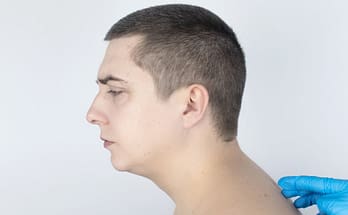Forward head posture is an issue that affects billions of people around the world. It’s when your head juts forward, either forward or to one side, in an unnatural position. This condition can be caused by a number of things: improper spinal alignment, poor balance and coordination, or just having a terrible habit of slouching too much in front of the TV.
If you’ve ever felt like your neck is sore after sitting at your desk all day, this post is for you! We’re here to cover what exactly FHP is and what causes it so we can start thinking about how we can correct our own posture problems.
The 42-pound head: What does it feel like?
So what’s the average weight of a human head?
According to researchers, it’s about 12 pounds (5 kg). But in an individual with forward head posture, that weight can quickly skyrocket by 10 or more pounds for each inch of forward head posture.
So if you have just one inch of FHP, that means you’re carrying around a 10-pound extra weight on your neck and spine all day long. If you have 3 inches of FHP, well – then you’re lugging around 42 pounds on your poor neck! Add this heavy load to the other pressures we face every day – poor posture while sitting at work or in front of the TV, the stress of daily life, etc – and it’s no wonder so many people deal with chronic pain and discomfort as they age.
But what causes FHP? And is there anything we can do to correct this problem and prevent it from getting worse? Let’s take a closer look at the causes of forward head posture, as well as some simple strategies for correcting your posture and improving your overall health.
What is forward head posture?
Forward head posture (FHP) is a condition in which the head is positioned too far forward on the shoulders. The head may be moved forward by a number of different factors, including poor posture, obesity, and prolonged use of computers or other electronic devices.
FHP can lead to a number of problems, including neck pain, headaches, and even dizziness. In severe cases, it can also cause nerve damage. FHP is diagnosed by taking X-rays or photographs of the head and neck. A physician will then measure the angle between the head and the neck to determine if there is indeed an excessive forward tilt.
Treatment for FHP typically consists of exercises that stretch and strengthen the muscles in the neck and shoulders. In some cases, a physician may also recommend wearing a neck brace or using electrical stimulation therapy to help correct the problem.
Causes of forward head posture
One of the most common causes of forward head posture is poor ergonomics. When sitting at a desk, many people hunch over their computer screen, rounding their shoulders and thrusting their heads forward. This posture puts a lot of strain on the neck and can lead to headaches, fatigue, and muscle tension.
Another common cause of forward head posture is malignment of the spine. This can be caused by a number of conditions, including scoliosis, kyphosis, and lordosis. When the spine is not properly aligned, it puts additional strain on the muscles and ligaments supporting the head, leading to fatigue and pain.
Forward head posture can also be caused by tight muscles in the neck and shoulders. This can be due to repetitive motions or prolonged periods of stress. When the muscles are tight, they pull on the bones and joints, causing them to shift out of alignment. This can lead to pain, stiffness, headaches, and even migraines.
Luckily, there are a number of treatments available for forward head posture. These include exercises to improve posture, massage therapy, and chiropractic adjustments. With proper treatment, it is possible to reduce pain, improve range of motion, and prevent further damage to the spine.
Common symptoms of FHP
The common symptoms of FHP are reduced range of motion in the neck, headaches, upper back pain, and fatigue.
People with this condition often have a hard time turning their heads from side to side, and they may feel like they need to crack their neck frequently.
Headaches are often one of the first signs of FHP, and they can range from dull and achy to sharp and debilitating.
Upper back pain is another common symptom, as the head puts extra pressure on the muscles and spine when it is allowed to fall forward.
Finally, fatigue is a common symptom of FHP as well, as the body expends extra energy trying to compensate for its poor posture. If you are experiencing any of these symptoms, it is important to see a doctor or chiropractor to get a proper diagnosis.
Long term effects of forward head posture on overall health
When you think about keeping a healthy posture, you might only consider how it affects your appearance. While it is true that poor posture can make you look slouchy and unattractive, the real problem with forward head posture is how it affects your health.
When your head extends too far forward, it puts a strain on your neck and upper back muscles, which can lead to headaches, migraines, and even chronic pain. Additionally, forward head posture can cause dizziness and balance problems, as well as contribute to issues like insomnia and TMJ disorders.
Over time, these problems can have a significant impact on your quality of life and can lead to more serious health issues, such as arthritis and even heart disease.
Benefits of good posture
Fortunately, there are a number of ways to address forward head posture and improve your overall health. One of the most effective strategies is to make sure that you maintain good posture at all times. This means sitting up straight with your shoulders back, and ensuring that the top of your head is aligned with the rest of your body.
Not only does proper posture help to prevent problems like FHP, but it can also improve circulation, boost energy levels, and reduce stress and anxiety. Plus, maintaining proper posture will give you extra confidence in how you look and feel – which can lead to better performance at work or school, as well as enhanced relationships with friends and loved ones. So if you want to live a healthier life with more energy and fewer health issues, be sure to work on your posture today.
How to prevent forward head posture
There are a number of steps that you can take to prevent forward head posture, including:
Make sure that you are paying attention to your posture at all times. This means sitting or standing up straight with your shoulders back and your head aligned with the rest of your body. You may even want to use reminders like a posture brace or an app on your phone to help keep you focused on proper alignment.
Incorporate regular stretching exercises into your daily routine, focusing on the muscles in the neck and upper back. These stretches can help relieve tension and reduce pain, making it easier for you to maintain good posture throughout the day.
Practice mindfulness techniques such as deep breathing and relaxation exercises, which can help you reduce stress and anxiety by focusing your mind on the present moment. These techniques can also help to rewire negative thought patterns that may be contributing to poor posture.
Make sure that you are getting enough sleep each night and eating a healthy, balanced diet. Getting adequate sleep can help improve your energy levels and focus, while a nutritious diet will give your body the fuel it needs to stay strong and healthy. And of course, staying well hydrated is also crucial for maintaining good posture.
How to fix forward head posture
If you have been diagnosed with forward head posture, there are a number of steps that you can take to correct and prevent this issue.
One strategy is to work with a physical therapist or chiropractor to develop an individualized treatment plan. This may include regular stretching exercises, massage therapy, and other techniques that can help release tension in the neck and upper back muscles.
Another option is to use tools like posture braces or ergonomic furniture, which can help keep your body aligned properly as you go about your day. And at night, it is important to get plenty of restful sleep so that your body has time to rejuvenate and repair itself.
Overall, whether you are looking for immediate symptom relief or long-term solutions to prevent FHP, it is important to take a holistic approach that addresses both the physical and emotional aspects of this condition. With consistent effort and the right support, you can achieve better health and well-being even if you have a forward head posture.
Forward head posture, or FHP, is a common condition that can have a significant impact on one’s health and well-being. While there are many strategies for addressing this condition, the most effective approach is to focus on both the physical and emotional aspects of FHP.
This may involve working with a healthcare professional such as a physical therapist or chiropractor. It may also involve using tools like posture braces or ergonomic furniture, and making sure to get plenty of restful sleep each night. With consistent effort and the right support, it is possible to achieve better health even if you have forward head posture.
FAQ
How long does it take to fix forward head posture?
The time it takes to correct forward head posture will depend on a number of factors, including the severity of the condition and your individual response to treatment. However, many people find that working with a healthcare professional such as a physical therapist or chiropractor can be an effective way to address FHP and reduce associated symptoms. Additionally, using tools like posture braces or ergonomic furniture, making sure to get enough sleep each night, and incorporating regular exercise into your routine may also help in this regard.
Can a chiropractor fix a forward neck?
In some cases, a chiropractor may be able to help correct a forward neck or other issues with posture. This will depend on the cause of the problem, as well as factors such as the severity of the condition and your individual response to treatment. However, working with a chiropractor in conjunction with other strategies such as stretching exercises, using posture aids like braces or furniture, and getting enough sleep each night can be an effective way to address FHP and improve your overall health and well-being.
How should I sleep to fix my forward neck posture?
There is no one “right” way to sleep in order to correct a forward neck posture, as the best approach will depend on your individual needs and preferences. However, some strategies that may be helpful include sleeping on your side rather than on your stomach or back.
In addition, you should use a supportive pillow or other aids to keep your spine aligned correctly as you sleep. Avoid activities like reading in bed or watching TV just before getting to bed. Ultimately, finding what works for you when it comes to getting restful sleep is key to addressing any condition related to poor posture.
What muscles are weak in a forward head posture?
There is no definitive answer to this question, as the specific muscles that are weak in forward head posture will vary from person to person. This is due to a number of factors, including the underlying cause of the condition. However, some common muscle groups that may be affected include those in the neck, upper back, and core, as well as those that control overall body alignment.
Working with a healthcare professional such as a physical therapist or chiropractor can help identify any specific areas of weakness so that you can focus your efforts on targeted strengthening exercises and other activities.
Does forward head posture cause a double chin?
There is no definitive link between forward head posture and a double chin, as this condition may be caused by a number of different factors. However, there is some evidence that FHP may contribute to the appearance of a double chin due to its effects on facial alignment and overall body positioning. Addressing any underlying causes of FHP, such as poor posture or muscular imbalances, can help reduce your risk of developing a double chin. In addition, it can improve other aspects of your overall health in the process.
Does sleeping without a pillow help forward head posture?
The best approach to addressing forward head posture will depend on your individual needs and preferences. However, some strategies that may be helpful include sleeping without pillows or other supports. These strategies include focusing on good posture while sitting or standing throughout the day, and avoiding activities like reading in bed just before going to sleep. Ultimately, finding what works for you when it comes to getting restful sleep is key to addressing any condition related to poor posture.
Can forward head posture cause anxiety?
Research has shown that poor posture in general can have a negative impact on mood and mental health. This may be due to the fact that FHP affects the proper functioning of many of the muscles and nerves involved in regulating stress responses. This can leave you more susceptible to feelings of tension or restlessness.
Furthermore, certain postural issues such as increased curvature in the upper spine can limit overall lung capacity and reduce oxygen intake. This can lead to symptoms like dizziness or lightheadedness that are often associated with anxiety.
Do chin tucks fix forward head posture?
Some strategies that may be helpful in correcting a forward neck posture include performing regular chin tucks or other exercises that focus on strengthening the muscles of the neck and upper back, modifying your posture throughout the day to keep yourself aligned correctly, and avoiding activities like reading in bed just before going to sleep. Ultimately, finding what works for you when it comes to maintaining good posture is key to improving overall health and well-being.
Can forward head posture cause dizziness?
Research has shown that FHP can lead to impaired nerve function in certain areas of the body, which may contribute to sensations like dizziness or lightheadedness. Additionally, poor posture in general can limit breathing capacity and reduce oxygen intake, leading to symptoms like headaches or fatigue that are often associated with anxiety or worry. Consulting with your doctor can help you better understand what may be causing these symptoms and find effective strategies for addressing them.
Do pillows cause forward head posture?
It is unclear whether a connection exists between pillows and forward head posture, as there has been limited research done on this topic. However, some experts believe that certain types of sleep supports can actually contribute to the development of FHP by encouraging slouching or poor postural alignment while you sleep. If you are experiencing pain or discomfort due to your sleeping habits, it is imperative to consult with a healthcare professional who can help you identify any underlying causes and develop an effective treatment plan for addressing them.




